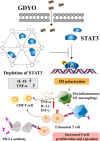An updated overview of some factors that influence the biological effects of nanoparticles
- PMID: 37711450
- PMCID: PMC10499358
- DOI: 10.3389/fbioe.2023.1254861
An updated overview of some factors that influence the biological effects of nanoparticles
Abstract
Nanoparticles (NPs) can be extremely effective in the early diagnosis and treatment of cancer due to their properties. The nanotechnology industry is developing rapidly. The number of multifunctional NPs has increased in the market and hundreds of NPs are in various stages of preclinical and clinical development. Thus, the mechanism underlying the effects of NPs on biological systems has received much attention. After NPs enter the body, they interact with plasma proteins, tumour cell receptors, and small biological molecules. This interaction is closely related to the size, shape, chemical composition and surface modification properties of NPs. In this review, the effects of the size, shape, chemical composition and surface modification of NPs on the biological effects of NPs were summarised, including the mechanism through which NPs enter cells, the resulting oxidative stress response, and the interaction with proteins. This review of the biological effects of NPs can not only provide theoretical support for the preparation of safer and more efficient NPs but also lay the foundation for their clinical application.
Keywords: biological effects; interaction; nanoparticles; oxidative stress; protein corona.
Copyright © 2023 Xuan, Zhang, Zhu and Zhang.
Conflict of interest statement
The authors declare that the research was conducted in the absence of any commercial or financial relationships that could be construed as a potential conflict of interest.
Figures







References
-
- Benayas E., Espinosa A., Portolés M. T., Vila-del Sol V., Morales M. P., Serrano M. C. (2023). Cellular and molecular processes are differently influenced in primary neural cells by slight changes in the physicochemical properties of multicore magnetic nanoparticles. ACS Appl. Mat. Interfaces. 15 (14), 17726–17741. 10.1021/acsami.3c02729 - DOI - PMC - PubMed
Publication types
LinkOut - more resources
Full Text Sources

